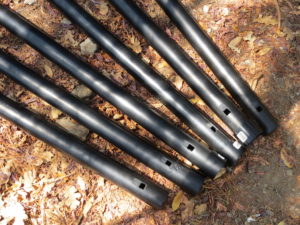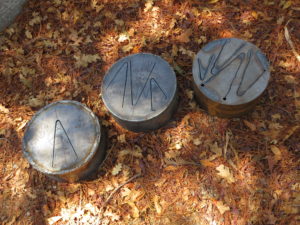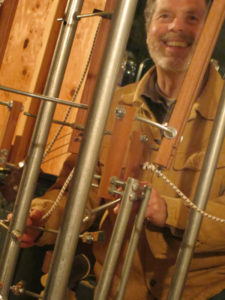The Center for New Music is participating in the Market Street Prototyping Festival, a collaborative effort to make the public space of San Francisco’s Market Street more active, vibrant, and engaging. C4NM’s project, Play Hear, is an invented instrument installation that aims to create space for spontaneous musical collaborations with friends and strangers of all ages and musical abilities. Play Hear is being led by Window Gallery curators Bart Hopkin and David Samas.
I’ve been working for several months on Play Hear. It’s a collection of sound instruments, all tuned to a just-intonation scale developed by the late composer Lou Harrison, all made to be easily playable by passers-by.
One of the great challenges in this project is in creating something that is completely safe, completely accessible to all, completely easy for the public to engage without need of special knowledge or skills, completely bomb-proof and even kid-proof, reasonably weather-proof – and yet still interesting and fresh feeling. With musical instruments, it’s hard to meet these requirements without being reduced to producing something acoustically rudimentary and musically trivial. Our team’s goal has been to find ways past the limitations and come up with a set of musical sound sources that will be engaging and fresh.
Pulling the whole thing together has been more work than I had bargained for. I’m fairly optimistic that the whole will come together in time. I am in a bit of a panic over a couple of things though. One is: this installation is going to be a hell of a job to transport to the site, assemble there, and then disassemble and cart away when the festival is over. And the other thing is: cart away to where? Surely after this much work we won’t want the installation to just disappear somehow. But finding a place for it to live, or even room to store it in a disassembled state, will be a challenge.

These flutes constitute the sounding elements for the instrument that we’re not calling Stomp Flutes. They will function like organ pipes sounded by air from bellows. Each flute has its own foot-operated bellows, and people visiting the installation will play the instrument by foot-pressing different bellows in turn to get different notes.
The reason they’re not officially to be called Stomp Flutes (despite the fact that that’s the name by which we’ve actually been referring to them all along) is that we don’t want people to stomp them. Experience has shown that stomping is what people often tend to do when they see the foot bellows, and the results are slightly outrageous sounds we’d rather avoid most of the time. A slow, steady pressure on the bellows yields a more pleasant sound. But I can never seem to remember the name we decided to call them instead of stomp flutes. It’ll come back to me sooner or later. The foot-bellows flute idea came from team member David Samas. Getting the air channel and edge just right to create a clear tone is a subtle business; in these flutes that was done by Peter Whitehead.

The most problematic of the instruments has been the steel tongue drums, which will be embedded in a set of benches. (The wooden seats of the benches will serve as soundboards. The sides of the benches will also be covered in wood, so that the partially enclosed volume of air under each bench will serve as a sound chamber.) The challenge with tongue drums – especially metal ones – is that the tongues tend to drive surrounding surfaces quite forcefully, and in so doing create a number of potential problems. Most vexing is that of destructive interference: If any two tongues or the surrounding surface itself happen to share any resonance frequencies that are close together but not identical in pitch, then they deaden one another’s vibrations almost entirely. To get around this problem, instead of making one big tongue drum bench with many tongues, we’re making several independent smaller drums, each with just three widely spaced notes. Two of these small but heavy drums are to be set in each bench. So far this seems to be working out OK. But the job of tuning all the tongues is not yet complete, and the proof will be in the pudding: if we can get all the tongues tuned to their intended pitches without the devil of destructive interference paying an unwanted visit, I’ll be very happy. Sudhu Tewari has been hugely helpful in moving these things along (he has both fabrication skills and lots of ideas and understanding). We’ll be attacking the problem with a vengeance once again as soon as he returns from Burning Man adventures.

The bamboos you can see here are based on the Indonesian instrument Angklung. Angklung are bamboo chimes with one very special feature: each length of bamboo is carved to the distinctive shape you can see in the photo, in order to open the bamboo along a portion of its length. The remaining tubular portion of the bamboo encloses a resonant air column analogous to that of a marimba bar resonator tube, and the length of this tubular section is adjusted so that its air resonance frequency matches the pitch of the woody tone of the bamboo itself. This greatly enriches the sound.
The four bamboos seen in the photo are all tuned to the same note. In our installation there will be six such sets of four, each tuned to a different note, with the six notes comprising a scale. They’ll be suspended high over the installation in such a way visitors below can activate them with a gentle push of the upright boards that support them.
When I first started working on this instrument, I was concerned about the fact that bamboo doesn’t age or withstand weather well. I hoped to come up with another, more stable material that would function similarly and sound just as good. I tried a variety of plastics, including some rather exotic and expensive ones. Nothing I tried sounded nearly as nice as bamboo. Also, working with the plastics, which release toxic dust and fumes when you try to machine them, was not good for the soul. I finally decided to just stick with the bamboo – perfect in every way aside from its impermanence.
 Bart Hopkin is a musician and instrument designer based in the SF Bay Area. Visit Bart’s website to learn more about his work and music.
Bart Hopkin is a musician and instrument designer based in the SF Bay Area. Visit Bart’s website to learn more about his work and music.